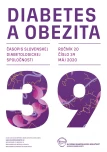-
Medical journals
- Career
Concentrations of fT3 in child patients with obesity
Authors: Dana Černochová 1; Jana Kohanová 1; Jana Poddaná 1; Eva Mendelová 1; Jarmila Vojtková 2; Miriam Čiljaková 1,2
Authors‘ workplace: Detské oddelenie, NEDÚ n. o., Ľubochňa 1; Klinika detí a dorastu, JLF UK a UNM, Martin 2
Published in: Diab Obez 2020; 20(39): 12-15
Category: Reviews
Overview
Introduction: Overweight and obese children may have higher fT3 serum levels. There are no studies known as yet which would describe the dependence of fT3 value on the actual weight gain over the last period. The aim of the study: The study focuses on examining the thyroid parameters, specifically fT3 in children with obesity, its correlation with BMI, weight gain and metabolic syndrome parameters.
Material and methodology: We included 88 children (45 boys) with obesity aged 10–18 years. We divided the cohort into two parts – one comprised 62 children with a stabilized weight, who had not gained more than 5 kg over the past 6 months. The other group of 26 children comprised patients who had gained more than 5kg over the past 6 months. We examined hormonal parameters in the children – TSH (thyrotropic hormone), fT3 (free T3), fT4 (free T4), and biochemical parameters, total cholesterol, TAG, LDL and HDL, fasting insulinemia. BMI (body mass index), waist circumference, BP (blood pressure) and the amount of weight gain over the past 6 months before examination in our department were recorded. The endocrine cause of obesity (hypercortisolism, thyroidopathy) was eliminated for all children, children with Prader-Willi syndrome as well as other obese children with mental retardation were eliminated.
Results: An average serum concentration of fT3 in the cohort of obese children was in the upper third of the reference norm. The total average of serum concentrations of fT3 for all obese children equalled 6.28 pmol/l. The norms for fT3 in our laboratory are 3.5–7.3 pmol/l for girls and 4.6–7.5 pmol/l for boys. The children who gained more than 5kg in weight over the past 6 months, had a significantly higher average concentration of fT3 than those with a stabilized body weight (6.81 pmol/l vs 6.09 pmol/l, p < 0.01). BMI values in both groups were comparable (34.05 kg/m² for children who gained weight vs 33.04 kg/m² for children with a stable weight).
Conclusion: The value of serum fT3 parameter positively correlates with a weight gain in child patients with obesity. Despite the comparable BMI, obese children with a greater weight gain over the past 6 months reached a significantly higher fT3 parameter compared to obese children with a stabilized weight.
Keywords:
obesity – fT3 – metabolic syndrome – childhood
Sources
- Goldemund K. Obezita a metabolický syndróm. Pediatr Praxi 2003; 4(1): 9–13
- Staník J, Barák L, Klimeš I (eds). Vybrané kapitoly z pediatrie. Diabetes a obezita u detí. Univerzita Komenského v Bratislave: Bratislava 2015. ISBN 978–80–223–3905–6. Dostupné z WWW: <https://www.fmed.uniba.sk/fileadmin/lf/sluzby/akademicka_kniznica/PDF/Elektronicke_knihy_LF_UK/Diabetes_obezita.pdf>.
- OECD Health statistics 2014. Dostupné z WWW: <https://www.oecd.org/els/health-systems/oecd-health-statistics-2014-frequently-requested-data.htm>.
- Bláha P. Využitie antropometrických metód v obezitológii. Postgrad Med 2002; 4(4): 416–421.
- Bianco AC, Kim BW. Deiodinases: implications of the local control of thyroid action. J Clin Invest 2006; 116(10): 2571–2579. Dostupné z DOI: <http://dx.doi.org/10.1172/JCI29812>.
- Biondi B. Thyroid and obesity: an intriguing relationship. J Clin Endocrinol Metab 2010; 95(8): 3614–3617. Dostupné z DOI: <http://dx.doi.org/10.1210/jc.2010–1245>.
- Kitahara CM, Platz EA, Ladenson PW et al. Body fatness and markers of thyroid function among U.S. man and woman. PLoS One 2012; 7(4): e34979. Dostupné z DOI: <http://dx.doi.org/10.1371/journal.pone.0034979>.
- Sanyal D, Raychaudhuri M. Hypothyroidism and obesity: An intriguing link. Indian J Endocrinol Metab 2016; 20(4): 554–557. Dostupné z DOI: <http://dx.doi.org/10.4103/2230–8210.183454>.
- Al-Musa HM. Impact of obesity on serum levels of thyroid hormones among Euthyroid Saudi Adults. J Thyroid Res 2017; 2017 : 5739806. Dostupné z DOI: <http://dx.doi.org/10.1155/2017/5739806>.
- Reinehr T. Thyroid function in the nutritionally obese child and adolescent. Curr Opin Pediatr 2011; 23(4): 415–420. Dostupné z DOI: <http://dx.doi.org/10.1097/MOP.0b013e328344c393>.
- Pacifico L, Anania C, Ferraro F et al. Thyroid function in childhood obesity and metabolic comorbidity. Clin Chim Acta 2012; 413(3–4): 396–405. Dostupné z DOI: <http://dx.doi.org/10.1016/j.cca.2011.11.013>.
Labels
Diabetology Obesitology
Article was published inDiabetes and obesity

-
All articles in this issue
- Editorial
- Comparison of the most recent guidelines for hyperglycemia management in patients with type 2 diabetes mellitus
- Concentrations of fT3 in child patients with obesity
- Non-alcoholic fatty liver disease from the point of view of diabetologist
- Diabetes mellitus and liver diseases
- The benefit of insulin glargine 300 U/ml for specific groups of patients in the context of available data
- Management of antidiabetic treatment in an elderly fragile patient with diabetes mellitus
- Peroral antidiabetics and thyroid diseases
- COVID-19: the topic of the day
- Comparison of cardiovascular studies with GLP-1 receptor agonists and their implication for clinical practice
- Therapy with SGLT2 inhibitors: case reports
- Treatment with the new modified insulin glargine (Semglee) in a patient with type 1 diabetes mellitus: case report
- A positive effect of intensification of the treatment with biosimilar insulin glargine on metabolic compensation: case report
- Treatment with biosimilar insulin glargine in clinical practice: case report
- Edukácia v diabetologickom edukačnom centre v Martine
- Diabetology EDUCATION FORUM
- Diabetes and obesity
- Journal archive
- Current issue
- Online only
- About the journal
Most read in this issue- Diabetes mellitus and liver diseases
- Treatment with the new modified insulin glargine (Semglee) in a patient with type 1 diabetes mellitus: case report
- Non-alcoholic fatty liver disease from the point of view of diabetologist
- Comparison of the most recent guidelines for hyperglycemia management in patients with type 2 diabetes mellitus
Login#ADS_BOTTOM_SCRIPTS#Forgotten passwordEnter the email address that you registered with. We will send you instructions on how to set a new password.
- Career
